
Canonization is the declaration of a deceased person as an officially recognized saint, specifically, the official act of a Christian communion declaring a person worthy of public veneration and entering their name in the canon catalogue of saints, or authorized list of that communion's recognized saints.

St. Canute's Cathedral, also known as Odense Cathedral, is named after the Danish king Canute the Saint, otherwise Canute IV. It is a fine example of Brick Gothic architecture. The church's most visited section is the crypt where the remains of Canute and his brother Benedict are on display.
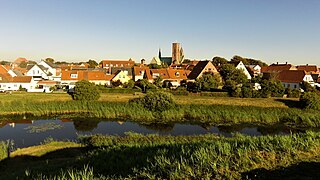
Ribe is a town in south-west Jutland, Denmark, with a population of 8,295 (2024). It is the seat of the Diocese of Ribe. Until 1 January 2007, Ribe was the seat of both a surrounding municipality and county. It is now part of the enlarged Esbjerg Municipality in the Region of Southern Denmark. It is the oldest town in Denmark.

In the Catholic Church, the Dicastery for the Causes of Saints, previously named the Congregation for the Causes of Saints, is the dicastery of the Roman Curia that oversees the complex process that leads to the canonization of saints, passing through the steps of a declaration of "heroic virtues" and beatification. After preparing a case, including the approval of miracles, the case is presented to the pope, who decides whether or not to proceed with beatification or canonization.

Christopher I was King of Denmark between 1252 and 1259. He was the son of Valdemar II of Denmark by his second wife, Berengaria of Portugal. He succeeded his brothers Eric IV Plovpenning and Abel of Denmark on the throne. Christopher was elected king upon the death of his older brother Abel in the summer of 1252. He was crowned at Lund Cathedral on Christmas Day 1252.
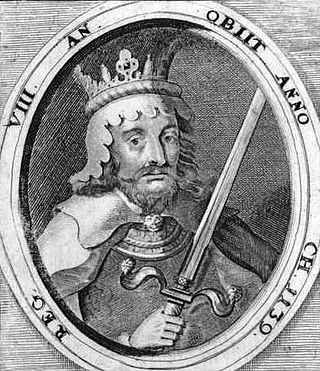
Eric II the Memorable was king of Denmark between 1134 and 1137. Eric was an illegitimate son of Eric I of Denmark, who ruled Denmark from 1095 to 1103. Eric the Memorable rebelled against his uncle Niels of Denmark, and was declared king in 1134. He punished his adversaries severely, and rewarded his supporters handsomely. He was killed by a subject in 1137 and was promptly succeeded by his nephew Eric III of Denmark.

Hans Tausen (Tavsen) nicknamed the “Danish Luther” was the leading Lutheran theologian of the Danish Reformation in Denmark. He served as Bishop of Ribe and published the first translation of the Pentateuch into Danish in 1535.

Hans Adolph Brorson was a Danish pietist clergyman, hymn write and translator of German language hymns. He served as Bishop of the Diocese of Ribe.

The former Diocese of Aarhus was a Roman Catholic diocese in Denmark, founded in the 10th century and dissolved during the Protestant Reformation. The diocese included the counties of Aarhus and Randers, the islands of Samsø and Tunø, and, after 1396, part of the county of Viborg.

The Catholic Church in Denmark is part of the worldwide Catholic Church, under the spiritual leadership of the Pope in Rome. The Diocese of Copenhagen covers the whole of the country, as well as the Faroe Islands and Greenland, and as such is one of the geographically largest Catholic dioceses by area in the world.

Adaldag was the seventh archbishop of Hamburg-Bremen, from 937 until his death.

The Christianization of Scandinavia, as well as other Nordic countries and the Baltic countries, took place between the 8th and the 12th centuries. The realms of Denmark, Norway and Sweden established their own archdioceses, responsible directly to the pope, in 1104, 1154 and 1164, respectively. The conversion to Christianity of the Scandinavian people required more time, since it took additional efforts to establish a network of churches.
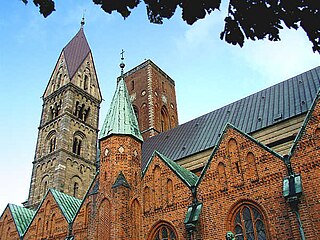
The former Diocese of Ribe was a Roman Catholic diocese in Southern Jutland, Denmark. The diocese was established in 948, and dissolved in 1536 during the Protestant Reformation. Within the newly established protestant Church of Denmark, the Diocese of Ribe effectively replaced its Roman Catholic precursor.
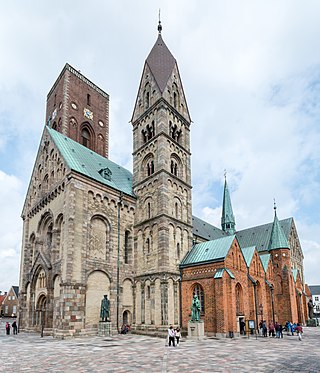
Ribe Cathedral or Our Lady Maria Cathedral is located in the ancient city of Ribe, on the west coast of southern Jutland, Denmark. It was founded in the Viking Age as the first Christian church in Denmark by Ansgar, a missionary monk from Hamburg, under permission of the pagan King Horik I. The cathedral has experienced several damaging events throughout its long history and has been restored, expanded and decorated repeatedly. As it stands today, Ribe Cathedral is the best preserved Romanesque building in Denmark, but reflects a plethora of different architectural styles and artistic traditions. It ranks among the most popular tourist attractions in Denmark and has been awarded two stars in the Michelin guide.
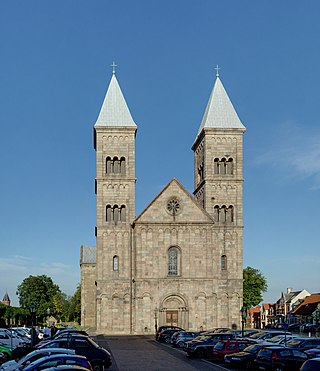
Viborg Cathedral, Our Lady Cathedral is the site of one of Denmark's most important historic churches located in the town of Viborg in northern Jutland. The modern building is a 19th-century construction based on Lund Cathedral in southern Sweden which bears no resemblance to the medieval cathedral that stood on the site since 1130.

The Diocese of Aarhus is one of 10 dioceses in the Church of Denmark, with headquarters in the city of Aarhus. The diocese covers a large district of northeast Jutland and comprises 14 deaneries, of which four cover the extent of Aarhus city itself.

The former Diocese of Viborg was a Roman Catholic diocese in Denmark. It was established in 1065 and was dissolved in 1536 during the Protestant Reformation.

Saint Niels of Aarhus or Niels the Holy was a Danish prince who lived an ascetic life and was revered as a saint in Aarhus until the 18th century even though he was never canonized.
The history of Christianity in Denmark started with Saint Willibrord's unsuccessful mission among the Danes in the early 8th century.
Reginbrand was a bishop of the Ancient See of Aarhus. He was ordained by bishop Adaldag of Hamburg-Bremen in 948 in the first ordination of bishops in the Scandinavian countries. The ordination had the explicit support of the pope who wished to expand Christianity into northern Europe. Adaldag ordained three bishops for the Jutland region; Harald to Slesvig, Ljufdag to Ribe and Reginbrand to Aarhus. The meeting was attended by Otto the Great and Louis IV along with 34 German, French and Danish bishops, in the St. Remigius Kirche in Ingelheim am Rhein.















